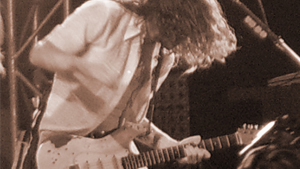John Frusciante Lesson: How to Play Like a Chili Pepper, Part 1

Josh Klinghoffer may be handling guitar duties in the Red Hot Chili Peppers these days, but for that signature Red Hot Chili Peppers sound, there's still no better reference than John Frusciante. In this classic interview/lesson with the ex-Pepper, Frusciante opens up and shares the secrets of his signature sound, including the essential chords, licks and techniques you need to know in order to play like a Pepper!
What might you play to kick off an improv jam with Flea and Chad?
Well, it could be anything. A lot of times it's a chord progression [Fig. 1], or just some groove. Around the time we were writing By the Way, I'd always be coming in with chord progressions like that-ones that have a real open, "human" sound to them. Something like that might end up being a section to a song. But sometimes those things don't go anywhere; they just go into the air. And I never remember anything, unless it's a thing I've justbeen doing. So I use a tape recorder a lot to record ideas.
What kinds of foundation do players need to get under their belts in order to improvise rhythm parts well?
To me, I think it's important, if you're in any given mode, to see the whole neck as one thing. The important thing is not the scale pattern; it's that those are the notes you could be playing at any given time. It's also important to remember the notes that aren't proper also have a place-whether it's passing notes, grace notes, or just this dissonant 12-tone thing. Once you see it that way, playing chords makes a lot more sense.
It definitely starts with understanding things like 7th, 9th, and 11th chordschords with a lot of numbers behind them. And it's important to recognize that, much of the time, a chord with five or six [different] notes in it won't make sense when you hear it by itself. That was my mistake growing up, because the only chord book I had was Ted Greene's Chord Chemistry. I would hear all these freaky chords and understand, "this chord is called 'this' because it's got these intervals in it," but I didn't know how to use them in context.
So I spent a lot of time looking at sheet music, studying music by people who use those interesting chords-like Burt Bacharach, Elton John, and the Beatles. When you open up their songbooks and see they're using something besides minor and major chords, you start to see the way you can use those chords.
For instance, I saw an E7b9 chord in a Fiddler on the Roofsongbook and a Beatles song. If you play E7b9 by itself, it's kinda dissonant. But when you go from E7b9 to Am [Fig. 2], it makes a lot more sense. By seeing the similarity of the way it was used in both situations, I ended up using it that way in something myself. There are also chords that sound kinda messy when you play them by themselves [Fig. 3A]. That's like an E and D chord combined. It's good to go to a Cmaj7 [Fig. 3B] from that. I like using chords that have so many intervals in them that they become kind of a washy texture, not really something somebody would hear and know exactly what it was.
All the latest guitar news, interviews, lessons, reviews, deals and more, direct to your inbox!
You've mentioned in interviews that you wanted to create guitar parts for By the Way that would be impossible to figure out.
Yeah, I used chord shapes like this [Fig. 4] for some things, where if I was learning it off the record I would never assume the person was doing that. I didn'twantto do things that were obvious, because I played like that on Blood Sugar and Californication.
A moment ago you stressed the importance of being able "to see the whole neck as one thing!' How would you recommend people go about learning the neck that thoroughly?
Well, I guess the first way is to practice scales and stuff, keeping in mind the important thing is not the scale pattern or how fast you can pick it but how those notes relate to each other and what intervals are being used. Some songs may contain certain bars that call for a major 6th, and with a chord change it may suddenly become a minor 6th. Or maybe something goes from a major chord to a minor chord with the same tonic [Fig. 5].
For the first chord, A Mixolydian [Fig. 6A] would fit nicely. And there's actually no 7th in the chord, so it's pretty much up for grabs; you could make it straight major if you want [Fig.6B]. And for the minor chord, I'm not playing a 6th [in the chord], so the mode is up for grabs, too [Figs. 7 A-B]. The whole point is that those chords are dictating what notes can be played over them.
